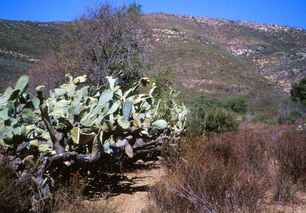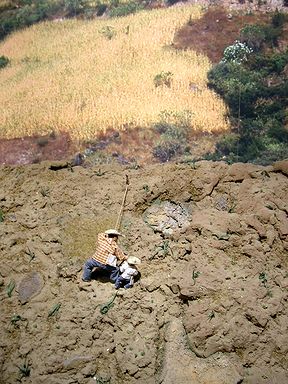
Field fences made of edible cactus are common throughout most of Mexico, providing privacy, food, and animal control all at once.
Content created: 2008-08-21
Part 6
Part 8

The Mexica, like their immediate allies and enemies, were lucky to live near a large lake, which provided aquatic animals (and other edible lake products) year round. But most of Mexico is mountainous. Despite rivers and a few lakes, it is subject to periods of dryness or even drought, like the drought that may have driven King Huémoc from Tóllan. The basic agricultural adaptation in this part of the world consists of maize, pole beans, squash (including pumpkin), and chiles. These were the Neolithic cultigens that made settled life possible in Mesoamerica and that, as we may see in a separate reading on the Hopi, still make up most of the diet among the northern, Puebloan peoples. Not surprisingly, these were the crops planted by the Mexica. (Click here to go to the Hopi reading.)
They were not, of course, the only crops. The common "beaver tail" cactus (opuntia vulgaris), for example, has fleshy edible leaves (nohpálli) still eaten under the name nopal, borrowed into Spanish from Náhuatl.
Not all crops are food crops. Century plants or maguey (Náhuatl: metl [Note 13]) were grown for their fibers, which were used for rope and rough clothing, and later for a kind of rough paper. (Well, all right, maguey could also be fermented to make pulque, a kind of beer. [Note 14])
In steep mountain areas, farming was ideally done by terracing the mountainside to create a series of more or less level fields. However, none of the commonest crops required level ground to grow, so long as water was sufficient. In some areas fields could be planted on a hillside and minimally maintained by a farmer supported in whole or in part by a rope tied to a stake in the ground above.

In marshy areas, chinampas were created by piling up mud drawn from under the water level, and we saw that creating chinampas was an early priority each time the Mexica were resettled. Chinampas, which were known throughout Mesoamerica, still exist in Lake Xochimílco, the surviving, southernmost, portion of Lake Tetzcóhco. They work well so long as there is a way to keep the mud from flowing down off of the islands and back into the water. Although woven reeds can be used to wall in the mud, and although they are almost essential for a new installation, the most successful long-term solution to the problem is to hold the soil in place by planting water-tolerant willow trees (Spanish: huejote from Náhuatl: huéxotl) around each artificial island. The spaces between islands serve as canals to transport people and goods from island to island. But such canals need to be constantly maintained both to keep the mud from seeping back in and to keep reeds from choking these canals. The reeds, although a nuisance when they block canals, were also a crop, with a wide range of uses, including the construction of simple houses. Over the years the Mexica built more and more chinampas, greatly extending their arable land as they reclaimed more and more of the shallow lake for agriculture. (Click here for More About Chinampas.)
Chinampas, while ingenious and very productive, required backbreaking work. But they also had other drawbacks. For example, the lake level depended in part upon the drainage from the surrounding mountains, which varied both seasonally and from year to year. It was never deep, but in time of drought the water level could drop until it became several different lakes (or swamps), while in wet times the rising water level could swamp low-lying chinampas, effectively destroying them. Further, although fresh water sources fed the south end of the lake system, this was not true in the north, and natural evaporation (which is severe in the summer at this altitude) tended to increase its salinity over time. Thus massive waterworks were eventually needed to maintain the system, especially as the population increased. Famously, a dike was constructed aimed to prevent saline water from moving from north to south, and irrigation canals were constantly being reengineered to control the height and flow of the water. Because the high-maintenance chinampa land was so valuable, seeds of plants that would tolerate transplanting were often sprouted in small fields (which may even have been floating rafts in a few cases) and then transplanted. This allowed a mature crop to occupy a field while its successor was just starting in the transplantation zone. Fortunately, the bottom muck constantly dredged from the lake floor was so fertile that it was not necessary to let these fields lie fallow. (O’Mack 1991)
| « Part 6 |
Contents Glossary, Bibliography | Part 8 » |